{2} Husk lives in a house that dates back to the late 1800s. Its main dining room was constructed in 1893 and "evokes the grandeur of Charleston, speaking to the transformation of the city over time." {3,7,8} The Victorian details and turned columns were "layered over the original Queen Anne-style façade through the years, eventually falling into disrepair until discovered by Husk ownership." While the building retains much of "its antique charm and stately character (with original windows and exposed brick throughout), the renovations imbued it with a modern, minimalist theme" -- notice the glasses filled with long sprigs of rosemary. Both floors are facing Queen Street with "sweeping piazzas (i.e., porches), and the courtyard allows diners to enjoy themselves in the late afternoon."
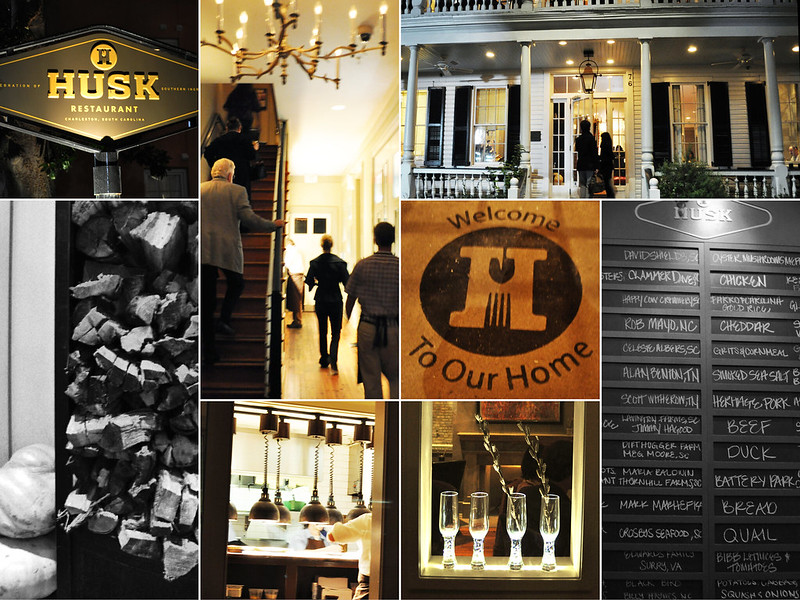
The emphasis at Husk is on the ingredients and the people who grow them -- {6} this chalkboard lists the artisanal products that were used that evening and continues to change as ingredients change. The menu changes twice, daily, based on what is freshest that day. Whatever they receive from its farmers and purveyors that day is what dictates the menu. {4} Wood-fire cooking is key at Husk, especially as Chef Brock strongly embraces that "'low and slow' imparts the most flavor." For this intent and purpose, Husk has two of its very own smokers, a barbecue pit and spit, and a wood-burning oven, all of which is fueled by an old-fashioned burn barrel. {7} The main part of the house features an open kitchen with a wood-burning oven and dining room. The open kitchen encourages a collaborative effort from the chefs as well as a free environment that allow them "to freely interact with their guests and personally deliver food to tables."
Chef Brock, along with his chef de cuisine Travis Grimes, "exhaustively research Southern food -- its history and provenance -- and in the process reconstitute flavors and ingredients lost to time." Just like at McCrady's, many of the produce used at Husk is grown in-house on the restaurant's garden, with a concentration on "heirloom grains and vegetables that once flourished in the region, but were lost to twentieth century industrial agriculture." Along with this, the kitchen takes "what is fresh and available today, or even this hour, and transform it into an evolving menu." As seasonal bounty "comes in waves," whatever they cannot use right away is preserved, pickled, smoked, and saved.
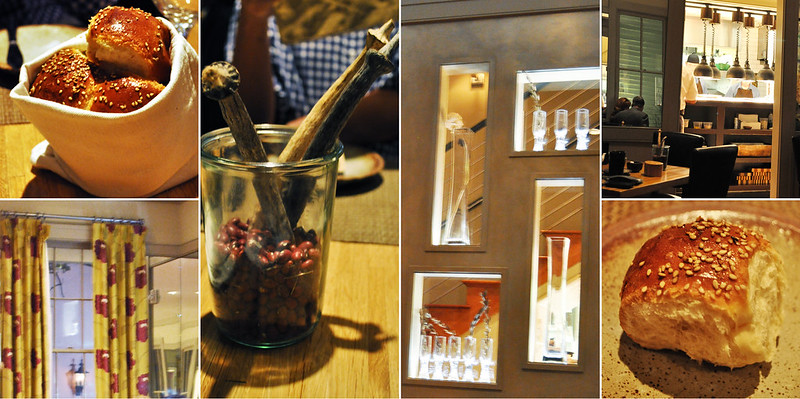
{2} At the center of every table is a glass jar filled with dried beans and okra husks -- how appropriate! {3,4,5} The dining room, as promised, was a harmonious marriage between antiquity and modernity. {1,6} To start, our server brought over a canvas sack filled with softest dinner rolls sprinkled with benne seeds. They went splendidly with a little smear of salted, creamy butter.
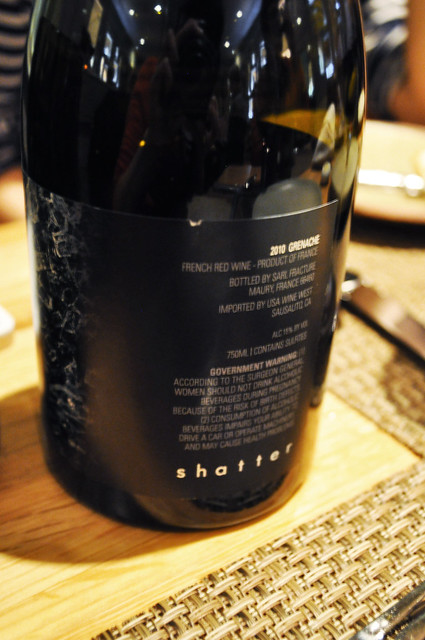
For the table, we shared a bottle of "Shatter" grenache from Languedoc-Roussillon, France with a 2010 vintage -- a brand produced by the collaborative efforts of Trinchero Family Estates and legendary winemakers Dave Phinney of Orin Swift Wines and Joel Gott of Joel Gott Wines. This grenache is sourced from 60-year-old French vines, and also happens to have a very high alcohol content at 15%. It was a little strong in that regard, but it went quite nicely with all of the dishes we had.
We decided to approach dinner at Husk family-style -- instead of each ordering a starter, main course, and dessert, we decided to share a bunch of appetizers, two main courses, a side, and a dessert.

First round of starters included the {1} Southern fried chicken skins with Steen's cane syrup and Louisiana hot sauce. Though it sounded pretty gnarly to be eating fried chicken skins (not going to lie -- at one point, to keep myself from feeling like a cholesterol-growing fatty, I had to psych myself into thinking they were fried calamari), they were REALLY good. Savory and incredibly rich, the fried chicken skins were made even tastier with the sweet thickness from the cane syrup and the balanced kick from the hot sauce. It's a must order for the table -- I bet you won't ever have anything quite like it! {2} Of course, to counteract the greasy goodness of fat from the chicken skins, we also ordered ourselves the Ambrose Farms arugula (salad) with sorhum glazed beets, pecan granola, house made manchego, and apple bourbon vinaigrette. Just like he wowed us at McCrady's, this arugula salad was another example of Chef Brock's handiwork with tasty compositions of greens. The beets, hearty granola, savory manchego, and flavorful vinaigrette made for the perfect winter salad -- warming and satisfying.
We also shared the {5} South Carolina shrimp with creamy Geechie Boy grits, tomato braised peppers and onions, Surry sausage, and a soft poached farm egg, which was by far my favorite dish at Husk. It had the best consistency of creaminess and stewiness (if that's even a word!) as the grits swam beautifully in the tomato stew of braised peppers, onions, and slightly spicy sausage -- it was an excellent blending of ingredients. It had all of the Southern trimmings with the succulent shrimp in a grit stew that you wanted to sweep up entirely with a loaf of warm, fresh bread. The soft poached egg added another fun element to the dish as well.
After we ate our way through those three dishes, next came {3} Dave's wood fired clams with sweet corn bisque, Benton's bacon, wilted arugula, roasted red peppers, and cornbread. I am sorry to say that this dish was quite disappointing -- the bisque was very salty, and the clams were just okay. Thankfully the cornbread and bits of bacon were the saving grace here. However, we had more luck with the {4} Tennessee pork ribs slow smoked with pecan shells, charred scallion barbecue glaze, roasted peanuts, and cilantro. Upon first bite, you could taste the intense smokiness seeped into the pork all the way into its bones. The edges were well-charred, and the glaze of barbecue mixed in with the toasted pecan shells and roasted peanuts was delightful. Very intense set of ribs -- lots of flavor packed into the petite things!
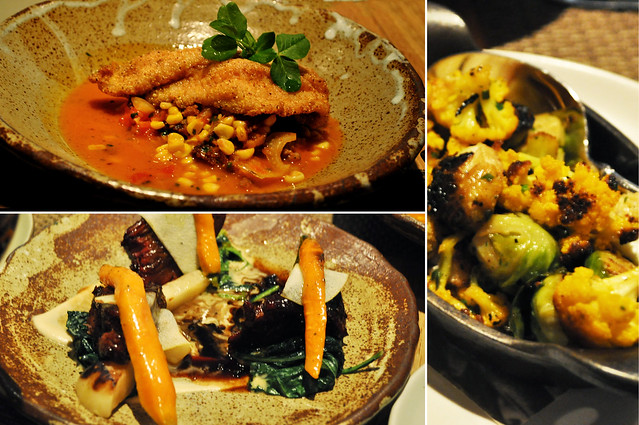
As one of our shared main courses, we had the {1} cornmeal dusted North Carolina catfish with roasted fennel and sweet corn, Benton's sausage, and preserved tomato broth. For me, this dish was on the medicore side -- it was pretty bland, even with the preserved tomato broth. I suppose I was expecting a little more out of this dish, but even with the cornmeal dusted on its exterior, the catfish was not as awesome as many of the other things that Chef Brock had cooked up for us here and at McCrady's.
Fortunately, our other choice of the {3} Blue Ridge bison short ribs with apple-celeriac purée, heirloom garden greens, turnips, baby carrots, and elderberry jus. I hadn't really had bison before (perhaps in a burger at one point), so I was curious to see what it really tasted like without it being blended in a grounded patty. It wasn't gamy one bit -- just heartier and meatier in taste than what you would normally expect in a typical beef short rib. As you would usually see mashed potatos or creamy polenta accompanied with short ribs, the apple-celeriac purée paired wonderfully here along with the heirloom greens and root vegetables -- it was certainly a wintry dish you wanted to sink your teeth in. The short ribs were nicely braised with that texture that you would find only from meat that fell easily off the bone, while the elderberry jus gave it a slightly sweet and tart flavor. As a side, we had the {2} cider braised Brussels sprouts and cauliflower, which were fantastic. The vegetables were glossed beautifully with a subtle yet flavor layer of glaze -- a little sweet and a little balsamic on the palate. Give me Brussels sprouts any day, and I'll be a happy camper!
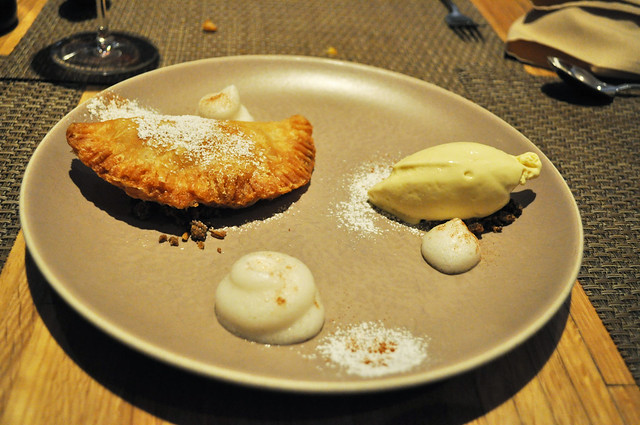
By the time dessert rolled around, our stomachs only had room for one shared dessert. The winner? The fried cameo apple pie with granola, cinnamon-maple whip, Anson Mills brewster oats, and ice cream. The pie itself was piping hot when it arrived to our table, so it was gratifying a la mode with the classic vanilla ice cream on its side and the spiced, lightly whipped cream. The cream melted right into the crevices of the encapsulating pie crust -- a nice end to a Southern-heavy meal.
After our dinner at Husk, though we were so full already, we hauled our butts over to the {1} Bar at Husk (right next door) for a little post-dinner digestif, just so we could take in the entire Husk experience.
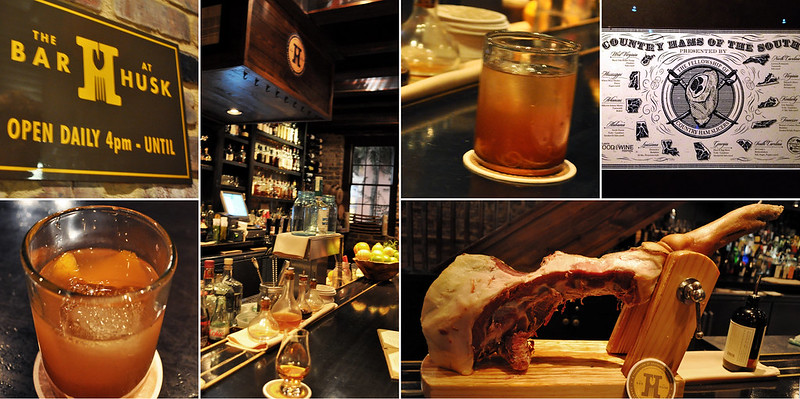
{2} The Bar at Husk is "a rusticated, exposed-brick affair, with a cozy, two-story outlay" -- the large upstairs has a lounge area with huge windows and seating for patrons, while the downstairs is this decked out little darkened bar, both with "accurate trim details that make them true to their historic roots but remain modern in disposition." I enjoyed a glass of the {5} Rosco pisco punch -- a concoction of pisco, bourbon, green tea, fire roasted orange, and raw sugar, while Alice had the {3} Charleston light dragoon's punch which was derived from a 1783 recipe discovered in the archives of the Preservation Society of Charleston -- a blend of California brandy, Jamaican run, beach brandy, black tea, lemon juice, and raw sugar. Undoubtedly seems like a Southern practice to incorporate tea into their spirited beverages, especially in punches like ours.
Along with the hand-crafted cocktails and punches, the drink menu at the Bar at Husk catalogs an insane amount of bourbon (varying in range for vintage, origin, proof, and distillation), five distinct regional madeiras (ranging up and down the East Coast), and five quality Southern artisanal ciders that meet the Bar's strict requirements (i.e., the use of Heirloom bitter cider apples as well as the production of pre-Prohibition-style dry ciders). The Bar's focus on cider in this regard is that over 100 years ago, more cider was consumed in this country than beer, but was drastically changed as the Prohibition devastated the industry, resulting in the cutting down and replacement of orchards as a result. Same goes for the emphasis of madeira on the menu, too -- the importation of wine was incredibly important to the colonists of Charleston as no wine quality grapes were grown in the region. Madeira was the main port that regularly set sail for the New World, consequently bringing madeira, a fortified wine, to colonial America and making it "the drink of choice for the elite and wealthy Southern plantation owners." Another attribute of madeira that made it so favorable to colonists was its unique winemaking process (i.e., "heating wine up to temperatures as high as 140° F for an extended period of time and deliberately exposing the wine to some levels of oxidation.") which resulted in a very robust libation that can have a long life of sustainability even after being opened.
While the four of us were ruminating over our stay in Charleston thus far (as well as digesting all of that food we just inhaled), the barkeeper brought out an entire leg of aged ham for a little shock value, though for us, it was just another instance of visual culinary indulgence. Turns out, this particular Kentucky country ham from Newsom's is processed by hand (in fact, by Husk's very kitchen) and hangs in the smokehouse for over 400 days (over one year!) before it is offered to Husk's patrons. when it is sold by the pound as an uncooked or cooked product. We were very lucky to sample a slice of this aged ham, and it rivaled some of the Iberico hams I've had in the past.
Findings: Our dinner at Husk was a very enlightening one -- one that brought us back to the days of authentic, polished Southern cuisine sprinkled with antebellum heirloom ingredients and preparation techniques. The amount of Southern history packed into the kitchen and cuisine at Husk is astounding, even in the subtlest of details (e.g., its table centerpieces and firewood display in the foyer). While a couple of the dishes were disappointing misses for us, I would have to say that the passion that weaves in and out of the hearth at Husk is tangible in Chef Sean Brock's cooking and his commitment to local suppliers, farms, and purveyors really makes the experience. Just writing this post alone, I learned so much about Southern cuisine about which I had no previously knowledge. The fact that Chef Brock and his team intensely research the history and provenance about everything that is and was Southern cuisine says enough. Indeed, Husk is truly celebrating Southern ingredients and redefining what it means to eat in Charleston -- the mission of Husk all along. The unbelievably dynamic menu (at least two change per day!) and chalkboard display say it all. Even the Bar at Husk right next door has its own charming ways, which makes me wish we had more time to spend there exploring the other spirits (i.e., the madeiras and ciders as well as the laundry list of bourbons) and drooling over slices of the aged Kentucky country ham.
I am so very glad we made time to stop here (along with McCrady's) to finally understand why Chef Brock has received so much press and acclaim over the past few years. It is so incredibly awesome to know that one guy has done so much for Southern cuisine. Rumor has it that he may be setting up shop in New York City next, so I cannot wait to see what he has in store. Until then, another trip down to Charleston may very well be in the cards.
Price point: $64 for bottle of grenache, $9-14 for each first course, $25-29 for each supper course, $7 for each side, $7 for dessert, $8 for each punch cocktail.
--January 6, 2013
Husk
76 Queen Street
Charleston, SC 29401
http://www.huskrestaurant.com

No comments:
Post a Comment